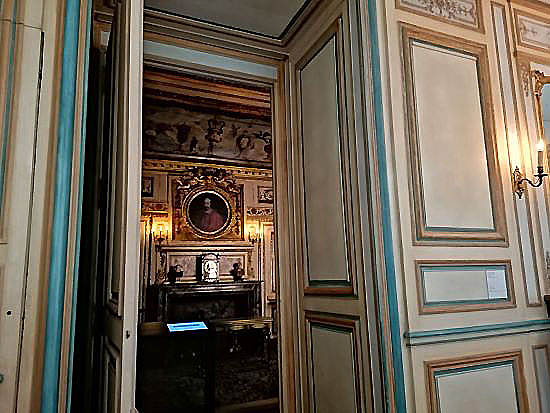UNIVERSAL MALE SUFFRAGE IN THIS MASSIVELY RURAL COUNTRY LED TO A NATIONAL ASSEMBLY DOMINATED BY THE FAR RIGHT
(IN APRIL 1848)
Conservatives' leader, the royalist Count Alfred de Falloux
His château / zoom
Alexis de Toqueville describes how notables control peasant votes.
Villagers meet in front of the church before marching in procession, two by two, to the voting site. There Toqueville makes a speech, telling them to remain together until all have voted and to ignore people who try to dissuade them.
-- Cited in Thiers, by Georges Valance
But deputies to the provisional government owe their seats to the street, which obtains...
- The right to organize: professional societies, which are embryonic unions, appear and between February and June 250 delegations solicit the Assembly. At the same time, 171 journals are founded (some say 300).
- A palliative to unemployment, the "National Workshops"
Les Ateliers nationaux ("The National Workshops") by Victor Adam, 1849 / zoom
Many are paid to do nothing.
Here the unemployed rest, bowl,
listen to a newspaper being read aloud
or hold a meeting under a banner
But a third of the out-of-work are artisans in luxury production, who are unfit for physical labor. As well, the government does not wish to compete with businesses, or confront employers who oppose whatever interferes with their control over labor.
The jobless nevertheless build the space in front of the Saint-Lazare railway station, build the Paris-Versailles line, accomplish other tasks in the suburbs and replace trees torn up for the February barricades. Their cost: 1% of the national budget.*
*Daily wage of a skilled worker, 3,50 francs.Workshop handout: 2 francs a day, reduced to 1,50 ( cost of bread, the staple, 35 centimes; a, deputy's salary, 25 francs)
- The violent repression of a revolt in Rouen (on April 27 and 28).
- The loss of the left's leaders when 130 "troublemakers" are arrested after a chaotic demonstration (on May 15):
L'Insurrection du 15 mai 1848, manifestations et la Garde nationale au Palais Bourbon / "Insurrection of May 15 1848, demonstrators and the National Guard at the Palais Bourbon") by Gaspard Gobaut, no date / zoom
Émeute du 15 mai 1848, invasion de l'Assemblée nationale ("Riot of May 15, 1848, Invasion of the National Assembly"), anonymous, 1848 / zoom
General Clément-Thomas (the incorruptible republican combattant of 1830) commands the forces that quell the "insurrection." Many years later, that action will seal his fate.
"Better a horrible end than horror without end!" The right girds for battle, focusing on the Workshops:
- "A strike that costs 170,000 francs a day... get rid of it!"
-- Count de Falloux
- Youths will be soldiers in Algeria and older men build canals or drain malarial swamps. Daily wage: 15 centimes.
On June 22 the Workshops close.
The unemployed march in cadence through the city,
chanting "We won't go, we won't go."
-- Toqueville
On June 23, "June" erupts.
* * *
Next,












.jpg)























